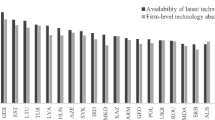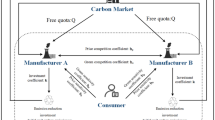Abstract
The goal of this paper was to develop a better understanding of how energy firms might respond to competitive pressures in the context of regulatory risk. We model how competitive pressures affect capacity investments that firms make into their portfolio of technologies. Using comparative statics, we characterize energy firms’ incentives to invest in different energy technologies under imperfect competition in outputs and prices and within different environmental regulatory regimes. We find that under Cournot competition, firms that invest in renewable technologies benefit from both strategic and spillover effects on their overall profits. Under Bertrand competition, these benefits are enjoyed only by firms that invest in conventional technologies. Our findings can provide guidance for policy makers. Notably, even relatively weak targets set by regulators are likely to spur additional investment into renewable technologies. Regardless of policy type, strategic interactions and spillover benefits drive the optimal management of energy technology R&D activities. Our results also suggest ways for regulators to exploit the inherent benefits of imperfections in competitive markets to stimulate firms’ efforts at improving on the technologies in their portfolios. Overall, our results describe how technology investment incentives are shaped by the strategic interactions between firms, market structures, and environmental policy choices.



Similar content being viewed by others
Notes
We are grateful to an anonymous reviewer for this observation.
We are grateful to an anonymous reviewer for helping us make this clarification.
References
Baker E, Clarke L, Shittu E (2008) Technical change and the marginal cost of abatement. Energy Econ 30:2799–2816
Baker E, Clarke L, Weyant J (2006) Optimal technology R&D in the face of climate uncertainty. Clim Change 78(1):157–179
Baker E, Shittu E (2006) Profit-maximizing R&D in response to a random carbon tax. Resour Energy Econ 28:160–180
Baker E, Shittu E (2008) Uncertainty and endogenous technical change in climate policy models. Energy Econ 30:2817–2828
Blanford G, Clarke L (2003) On the optimal allocation of R&D resources for climate change technology development. Technical Report UCRL-TR-200982, Lawrence Livermore National Laboratory
Corbett CJ, Kleindorfer PR (2001b) Environmental management and operations management: introduction to part 2 (integrating operations and environmental management systems). Prod Oper Manag 10(3):225–227
Corbett CJ, Klassen RD (2006) Extending the Horizons: environmental excellence as key to improving operations. Manuf Serv Oper Manag 8:5–22
Downing PB, White LJ (1986) Innovation in pollution control. J Environ Econ Manage 13:18–29
Farzin YH, Kort PM (2000) Pollution abatement investment when environmental regulation is uncertain. J Public Econ Theory 2:183–212
Fischer C, Parry IWH, Pizer WA (2003a) Instrument choice for environmental protection when technological innovation is endogenous. J Environ Econ Manage 45(3):523–545
Fischer C, Parry IWH, Pizer WA (2003b) How large are the welfare gains from technological innovation induced by environmental policies? J Regul Econ 23:237–255
Fulton M, Kahn B, Melquist N, Soong E, Baker J, Cotter L (2010) Growth of U.S. climate change litigation: trends & consequences. Deutsche Bank Report
Goulder LH, Parry IWH (2008) Instrument choice in environmental policy. Rev Environ Econ Policy 2(2):152–174
Goulder LH, Schneider SH (1999) Induced technological change and the attractiveness of \(\text{CO}_2\) abatement policies. Resour Energy Econ 21:211–253
Goyal M, Netessine S (2007) Strategic technology choice and capacity investment under demand uncertainty. Manage Sci 53(2):192–207
Green RJ, Newbery DM (1992) Competition in the British electricity spot market. J Polit Econ 100(5):929–953
Gritsevskyi A, Nakicenovic N (2000) Modeling uncertainty of induced technological change. Energy Policy 28:907–921
Islegen O, Reichelstein S (2011) Carbon capture by fossil fuel power plants: an economic analysis. Manage Sci 57(1):21–39
Jaffe AB, Newell RG, Stavins RN (2002) Environmental policy and technological change. Environ Resourc Econ 22:41–70
Jiang X, Parker G, Shittu E (2015) Envelope modeling of renewable resource variability and capacity. Comput Oper Res. doi:10.1016/j.cor.2015.07.020
Joskow PL (2008) Lessons learned from electricity market liberalization. Energy J 29:9–42
Klemperer PD, Meyer MA (1989) Supply function equilibria in oligopoly under uncertainty. Econometrica 57(6):1243–1277
Krass D, Nedorezov T, Ovchinnikov A (2013) Environmental taxes and the choice of green technology. Prod Oper Manage 22(5):1035–1055
Lee (2014) Half of power plant capacity additions in 2013 came from natural gas. EIA http://www.eia.gov/todayinenergy/detail.cfm?id=15751
Lerer L, Lomax S (2010) Utility companies ’just exhausted’ after defeat on climate bill. Bloomberg http://www.bloomberg.com/news/2010-07-26/utility-companies-just-exhausted-after-defeat-on-cap-and-trade-measure.html
McKitrick R (1999) A derivation of the marginal abatement cost curve. J Environ Econ Manage 37:306–314
Milliman SR, Prince R (1989) Firm incentives to promote technological change in pollution control. J Environ Econ Manage 17:247–265
Montero J-P (2002) Permits, standard, and technology innovation. J Environ Econ Manage 44:23–44
Newell RG, Jaffe AB, Stavins RN (1999) The induced innovation hypothesis and energy-saving technological change. Q J Econ 114:941–975
Nordberg-Bohm V (1999) Stimulating ’green’ technological innovation: an analysis of alternative policy mechanisms. Policy Sci 32(1):13–38
Nordhaus WD (2002) Modeling induced innovation in climate change policy. In: Grubler A, Nakicenovic N, Nordhaus WD (eds) Technological change and the environment. RFF and IIASA, Washington D.C. and Laxenburg, Austria, pp 182–209
Nyiwul L, Shittu E (2013) Market structure and the enforcement of emissions taxes. Interdiscip Environ Rev 14(3):269–280
Nyiwul L, Shittu E, Dhanda KK (2014) Prescriptive measures for environmental performance: emission standards, overcompliance, and monitoring. Clean Technol Environ Policy 17(4):1077–1091
Parry I (2003) On the implications of technological innovation for environmental policy. Environ Dev Econ 8:57–76
Requate T (2005) Dynamic incentives by environmental policy instruments–a survey. Ecol Econ 54(2–3):175–195
Requate T, Unold W, Strasse B (2003) Environmental policy incentives to adopt advanced abatement technology: will the true ranking please stand up? Euro Econ Rev 47:125–146
Richels RG, Blanford GJ (2008) The value of technological advance in decarbonizing the U.S. economy. Energy Policy 28:907–921
Shittu E (2014) Energy technological change and capacity under uncertainty in learning. IEEE Trans Eng Manage 61(3):406–418
Shittu E, Baker E (2009) A control model of policy uncertainty and energy R&D investments. Int J Global Energy Issues 32(4):307–327
Shittu E, Baker E (2010) Optimal energy R&D portfolio investments in response to a carbon tax. IEEE Trans Eng Manage 57(4):547–559
Stiglitz JE (2003) The roaring nineties: a new history of the world’s most prosperous decade. W.W. Norton and Company, Inc., New York
Subramanian R, Gupta S, Talbot B (2007) Compliance strategies under permits for emissions. Prod Oper Manage 16(6):763–779
Sue WI (2003) Induced technical change and the cost of climate policy. Technical report 102, MIT joint program on the science and policy of global change
Wald M (2008) Utilities turn from coal to gas, raising risk of price increase. New York Times http://www.nytimes.com/2008/02/05/business/05gas.html
Weigelt C, Shittu E (2015) Competition, regulatory policy, and firms’ resource investments: the case of renewable energy technologies. Acad Manage J 1–48. doi:10.5465/amj.2013.0661
Weitzman ML (1974) Prices vs. quantities. Rev Econ Stud 41:477–491
Xepapadeas AP (1992) Environmental policy, adjustment costs, and behavior of the firm. J Environ Econ Manage 23(3):258–275
Author information
Authors and Affiliations
Corresponding author
Appendix
Appendix
1.1 Two energy firms
In this section, we examine two energy firms in their primary states of jurisdiction—Xcel in Colorado and Florida Power and Light (FPL) in Florida—with respect to their energy technology portfolios and how their strategic investment plans are shaped by their emissions reduction plans. Figure 4 shows the current mix of technologies at the two firms. FPL generate their supplies primarily from natural gas plants while Xcel engages more coal plants. In terms of their renewable contents, Xcel has a significantly higher proportion than FPL. In order to implement Colorado’s Clean Air-Clean Jobs Act (ACT), Xcel examined three scenarios that would allow the firm to achieve its emissions reduction plan. Of the seven coal plants in Colorado, Xcel has scheduled one for retirement and aims to either retire or retrofit another four by implementing emissions control on them. The control is to replace the coal-fired generators with gas-fired technologies. Thus, in the context of this article, we interpret Xcel as the firm with investments into conventional resources.
FPL is an energy company with a carbon dioxide emissions rate that is 35 % lower than the industry average. With over 75 % of its generation capacity from clean-burning natural gas, FPL also generates a significant portion of power production from nuclear. FPL commenced operation of commercial-scale solar generation facilities in 2009 and 2010. Due to their focus on solar and other renewable technologies, we characterize FPL as the firm with investments into the renewable components of its portfolio.
1.2 Cournot equilibrium: optimal outputs and price
Taking the first-order conditions of the firms’ profit functions, we have
Substituting the linear inverse demand function,
where \(\lambda =1\), we have
Solving both expressions simultaneously, we have,
Substituting these into the (39), we have the market price for the outputs as
1.3 Bertrand equilibrium: optimal prices
Substituting \(q_{i}=\frac{1}{1-\lambda ^{2}}\left( a(1-\lambda )-p_{i}+\lambda p_{j})\right)\) \(i,j=1,2\) and \(i\ne j\), and \(\frac{ {\mathrm{d}}q_{i}}{{\mathrm{d}}p_{i}}=\frac{{\mathrm{d}}q_{j}}{{\mathrm{d}}p_{j}}=-\frac{1}{1-\lambda ^{2}}\) into these expressions, we have
Similarly,
The simultaneous solution to (42) and (43) gives the expressions in (24).
1.4 Signing the Hessian
We obtain similar results for \(\frac{d^{2}\pi _{j}}{{\mathrm{d}}q_{j}^{2}}\) and \(\frac{ \partial ^{2}\pi _{j}}{\partial q_{i}q_{j}}\). In absolute terms, \(\left| \frac{d^{2}\pi _{i}}{{\mathrm{d}}q_{i}^{2}}\right| >\left| \frac{\partial ^{2}\pi _{j}}{\partial q_{i}q_{j}}\right|\), thus, in magnitude terms,
1.5 Proof of proposition 2
Proof
Consider a firm with a portfolio of technologies seeking to choose the outputs, \(q_{i}\), from the independent sources to satisfy demand at minimum cost. We formulate this model as
subject to \(-\Sigma e_{i}q_{i}\ge -\bar{e}\), and \(\Sigma q_{i}\ge \overline{q}\). \(c_{i}\) is the output unit cost, \(e_{i}\) represents the emissions coefficient of the output sources, \(\bar{e}\) is the limit of aggregate emissions by the regulator, and \(\overline{q}\) is the output demand to be satisfied. Dropping the summations, the Lagrangian for this problem can be written as
where \(\omega 1\) is the marginal cost of abatement and \(\omega 2\) is an output shadow price. The Kuhn–Tucker first-order conditions are
To simplify, let \(q_{i}=\frac{\overline{q}}{n}\ \equiv \hat{p}\) where n is the number of technologies in the portfolio. Thus, substituting (50) into (49), we have, \(e_{i}=\frac{\bar{e}}{\hat{q}}\). Finally, putting this into (48), we have
The marginal abatement cost, \(\omega _{1}\) increases as the regulator’s emissions target, \(\bar{e}\) reduces, and thus influences the firm’s efficient frontier on the choice of technologies to satisfy the constraints. \(\square\)
1.6 Proof of proposition 3
Proof
Using stylized functions for linear marginal cost curves in Fig. 5, let \(e^{\prime }\) be the standard abatement level that makes the firms indifferent in their marginal costs. This standard limit is:
\(e^{\prime }>0\) because \(c>b\) (by definition). Shaded in Fig. 5 is the region where the emissions policy is higher than the ‘equilibrium’ limit, i.e., \(e^{\prime }<e_{H}\), then \(be_{H}>\max (ce_{H}-k,0)\). For \(e^{\prime }>e_{L}, be_{L}<\max\,(ce_{L}-k,0)\). \(e_{L}\) and \(e_{H}\) are low and high abatement levels, respectively. Tying this with (6), we characterize the optimal output relationships as follows:
\(\square\)
Rights and permissions
About this article
Cite this article
Shittu, E., Parker, G. & Jiang, X. Energy technology investments in competitive and regulatory environments. Environ Syst Decis 35, 453–471 (2015). https://doi.org/10.1007/s10669-015-9569-y
Published:
Issue Date:
DOI: https://doi.org/10.1007/s10669-015-9569-y






